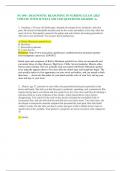NU 690 : DIAGNOSTIC REASONING IN NURSING EXAM | 2025
UPDATE WITH 30 WELL SOLVED QUESTIONS GRADED A+
1. Jonathan, a 36-year-old landscaper, abruptly developed fever, headache, and joint
pain. He noticed a blanchable macular rash on his wrists and ankles a few days after the
onset of fever, that quickly spread to the palms and soles before becoming generalized.
The rash is now petechial. You suspect that Jonathan has:
A. Rocky Mountain spotted fever.
B. flea bites.
C. Kawasaki syndrome.
D. Lyme disease.
Reference: https://www.mayoclinic.org/diseases-conditions/rocky-mountain-spotted-
fever/symptoms-causes/syc-20361032
Initial signs and symptoms of Rocky Mountain spotted fever often are nonspecific and
can mimic those of other illnesses: High fever, Chills, Severe headache, Muscle aches,
Nausea and vomiting. The red, nonitchy rash associated with Rocky Mountain spotted
fever typically appears three to five days after the initial signs and symptoms begin. The
rash usually makes its first appearance on your wrists and ankles, and can spread in both
directions — down into the palms of your hands and the soles of your feet, and up your
arms and legs to your torso.
2. Denise, age 37, presents to your office for generalized joint pain especially in the
knees and hands. She tells you that the pain is moderate, spreading, and symmetrical. She
reports having had a sore throat and low-grade fever for a few days and then developing a
rash described as warm erythema of the cheeks, which lasted about 4 days before
disappearing. You ask her if the rash on the cheeks included the nasolabial folds or
circumoral skin, and she tells that the rash did not cover these areas. Two days later, she
developed a nonspecific macular eruption that preceded the joint pain. Her rash faded
within 2 weeks, but she tells you that it comes and goes if she’s bathed in hot water or
spends time in the sunlight. Your patient’s symptoms are most consistent with a diagnosis
of:
A. rubella.
, B. erythema infectiosum.
C. rheumatoidarthritis.
D. scarlet fever.
Reference: https://www.nationwidechildrens.org/conditions/fifth-disease
(Erythema infectiosum) Fifth disease is a mild illness caused by a virus called parvovirus
B19. It is rarely serious. Its most obvious symptom is the bright red rash or “slapped
cheek” look of the face. The disease occurs most often during the late winter and early
spring in children between the ages of 4 and 10. However, older children and adults,
especially females, can get it. Symptoms: Mild fever, Mild headache, Cold-like
symptoms (stuffy or runny nose, sore throat), Fatigue, Mild muscle or joint pain and
swelling, especially in older children and women. 2 to 3 weeks after exposure, Bright
red, “slapped cheek” rash on face may appear and spread to chest, arms and thighs. The
rash may come back after several weeks. It can be triggered by sunlight, exercise,
extremes of heat or cold or emotional stress.
3. Eric, an obese 44-year-old, cut his right leg 3 days ago while repairing his roof. Today
his right lower leg is warm, reddened, and painful without a sharply demarcated border.
What do you suspect?
A. Diabetic neuropathy
B. Cellulitis
C. Peripheral vascular disease
D. A beginning stasis ulcer
Reference: https://www.cdc.gov/groupastrep/diseases-hcp/cellulitis.html
Cellulitis affects structures that are deeper than areas affected by impetigo or erysipelas.
As a result, the affected skin usually has a pinkish hue with a less defined border,
compared to erysipelas that presents with well-demarcated borders and a bright red color.
4. Dominique, a 22-year-old student, presents to your clinic for a rash that began on his
more concentrated on the lower abdomen and pubic area. In obtaining a history of the
present illness, he reports that he had an upper respiratory infection one month before the
rash developed. He tells you it started with one large lesion on his left chest that was oval
shaped, and 1 to 2 weeks later he developed numerous smaller lesions on the lower
abdomen and groin. It has been 2 weeks since the smaller lesions developed, and he tells
you he is concerned that the rash isn’t improving. As you examine the patient you note
that the lesions are salmon colored and have a thin collarette of scale within the lesion.
The original lesion is still present. You suspect Dominique has:
A. guttate psoriasis.
B. tinea versicolor.
C. secondary syphilis.
D. pityriasis rosea.
Reference: https://rarediseases.org/rare-diseases/pityriasis-rosea/




